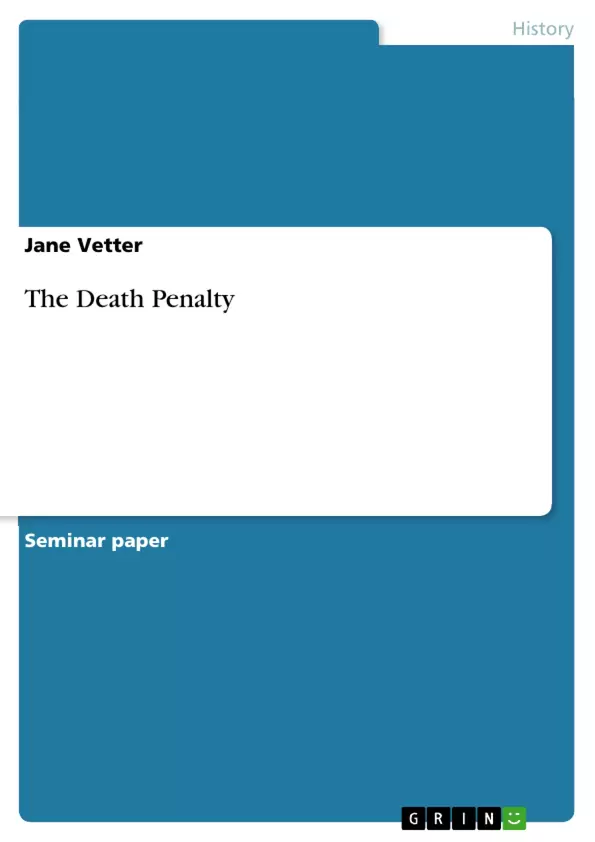According to the NAACP Legal Defense and Educational Fund Fall 2006 report, the total
number of death row inmates amounts to 3,344. There are roughly 41 percent black and 45 percent
white prisoners awaiting their execution. Since the reinstatement of capital punishment in 1976,
1047 people have been executed. (Death Row 1, 5). Among all U.S. states allowing the death
penalty, California, Texas and Florida have the most criminals on death row (Death Row 29).
Normally, major reasons in favor of capital punishments are retribution, deterrence, and the
general protection of society. Many people experience poetic justice and indemnification when
murderers receive their death sentences. They disregard the unproportional, high cost of the capital
punishment process which evolves due to repeated appeals and prisoners spending years or even
decades on death row (Banner 295).
Inhaltsverzeichnis (Table of Contents)
- The Role of Slavery and Racism
- Cultural Considerations
- Technological Innovations
- Legal and Constitutional Arrangements
- Culture War Politics
Zielsetzung und Themenschwerpunkte (Objectives and Key Themes)
This essay explores the reasons behind the continued use of the death penalty in the United States, despite its abolition in most Western countries. It examines the role of historical factors, particularly slavery and racism, as well as the influence of cultural considerations and technological advancements. The main focus, however, is on the impact of legal and constitutional arrangements, and the role of culture war politics in shaping public opinion and political discourse surrounding capital punishment.- The persistence of racial bias in the application of the death penalty
- The influence of cultural factors, including American exceptionalism, on attitudes towards capital punishment
- The role of technological advancements in shaping the public perception and execution methods of the death penalty
- The impact of legal and constitutional arrangements on the retention of capital punishment in the U.S.
- The influence of culture war politics and public opinion on legislative and judicial processes related to the death penalty
Zusammenfassung der Kapitel (Chapter Summaries)
- The Role of Slavery and Racism: This section discusses the enduring legacy of slavery and racism on the death penalty in the United States. It highlights the disproportionate representation of racial minorities on death row and the historical role of lynching and racially motivated executions. It also addresses the persistence of racial bias and the challenges of addressing this issue.
- Cultural Considerations: This section examines the concept of American exceptionalism and its influence on the continued use of the death penalty. It criticizes the idea that American culture inherently supports capital punishment and argues that historical factors, including the timing of the shift towards retaining capital punishment, play a more significant role.
- Technological Innovations: This section analyzes the impact of technological innovations on the death penalty, specifically focusing on the development and use of lethal injection. It discusses the perceived "barbarity" of older execution methods and how the shift towards more impersonal methods has influenced the public perception of the death penalty.
- Legal and Constitutional Arrangements: This section examines the role of American legal and constitutional structures in maintaining the death penalty. It emphasizes the unique features of the U.S. system, such as separation of powers and the influence of public opinion, which create challenges for abolishing capital punishment.
- Culture War Politics: This section explores the impact of culture war politics on the death penalty. It highlights how the death penalty has become intertwined with broader issues of morality and social values, influencing political discourse and the willingness of politicians to oppose capital punishment.
Schlüsselwörter (Keywords)
The main keywords and themes of this text include: death penalty, capital punishment, racism, racial bias, American exceptionalism, cultural considerations, technological innovations, legal and constitutional arrangements, culture war politics, public opinion, political discourse, and abolition.- Arbeit zitieren
- Jane Vetter (Autor:in), 2007, The Death Penalty, München, GRIN Verlag, https://www.hausarbeiten.de/document/116458


